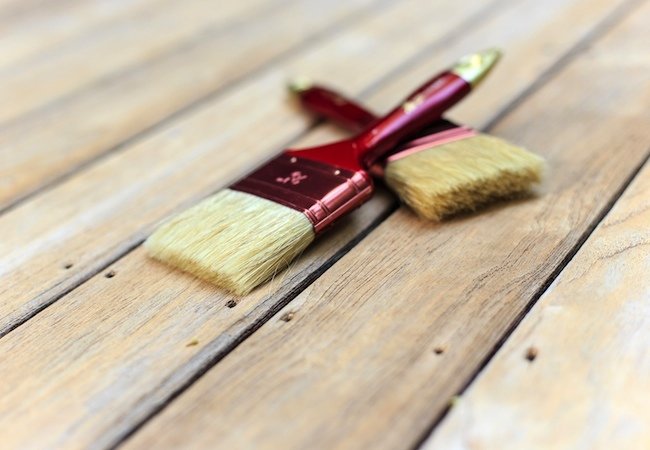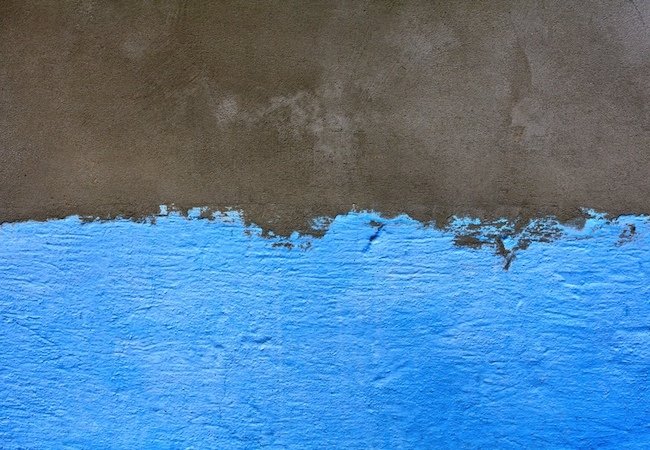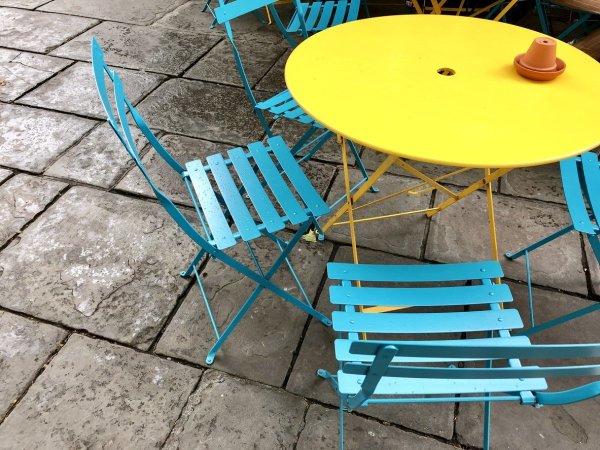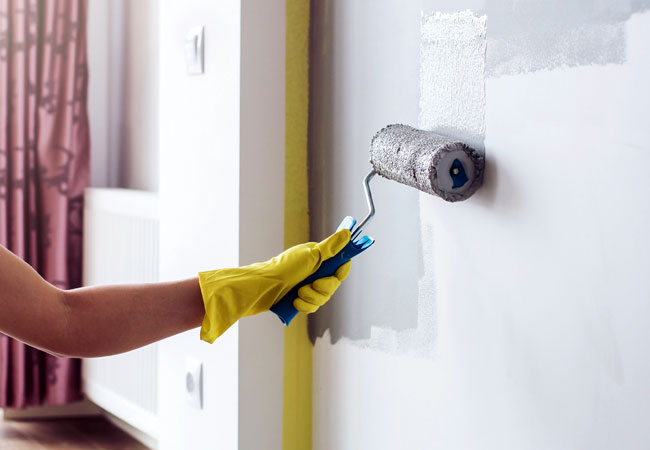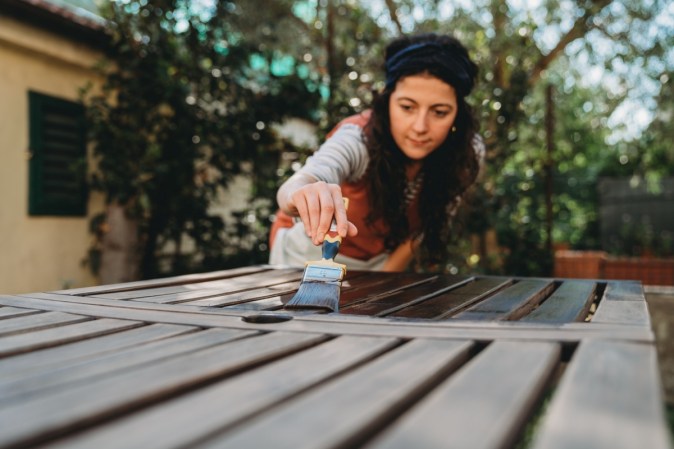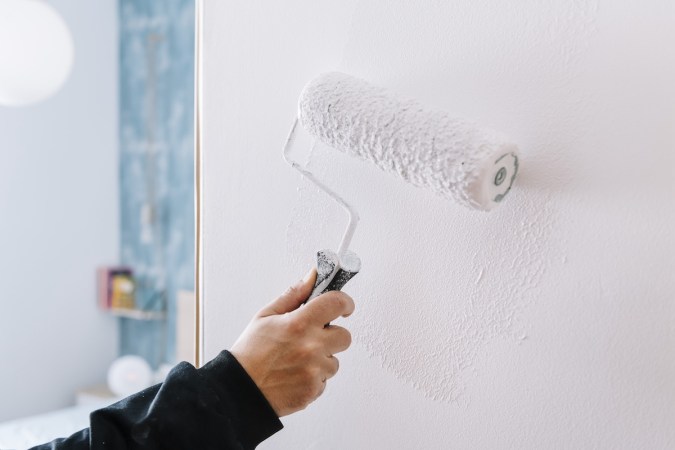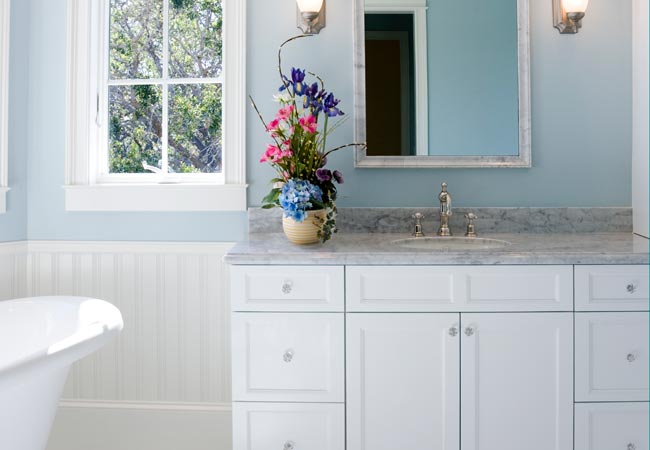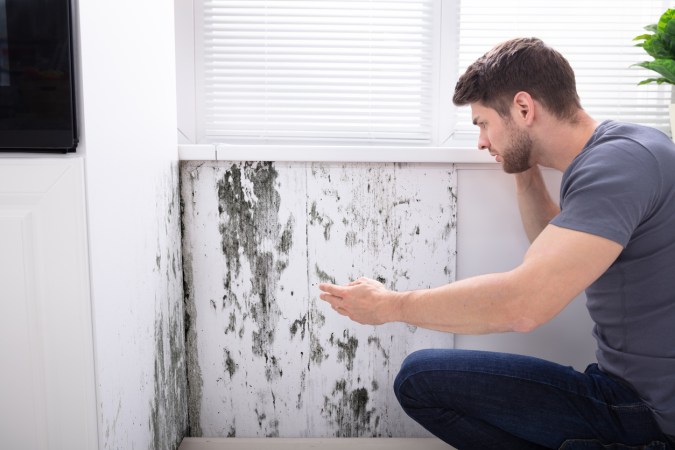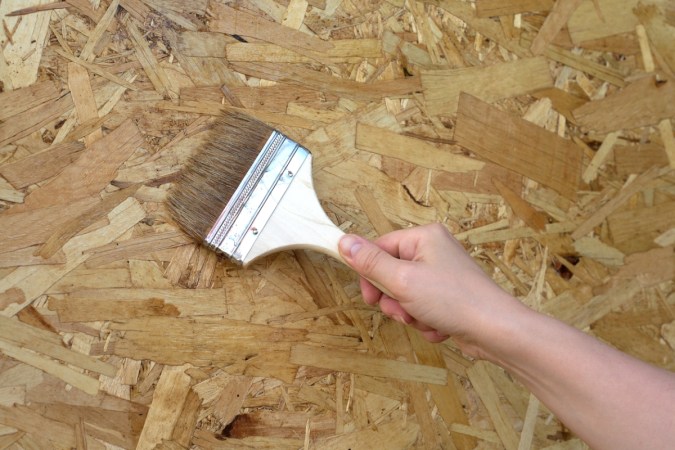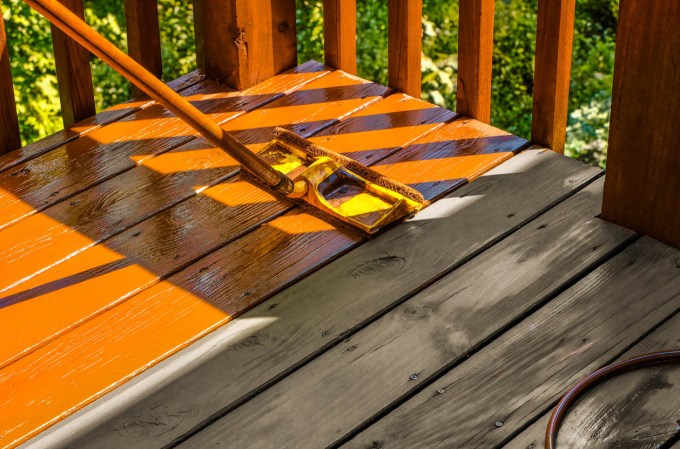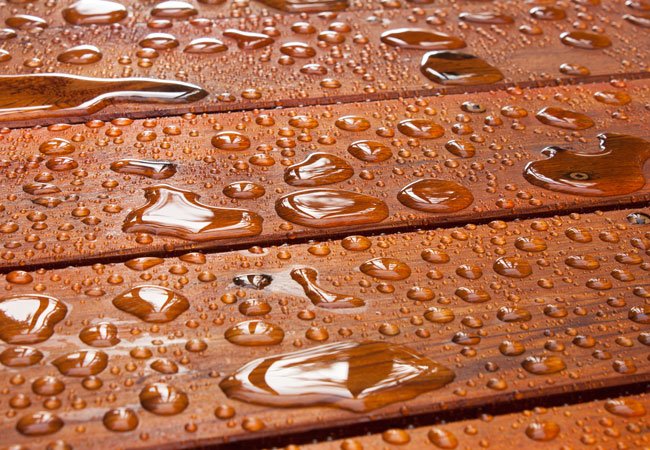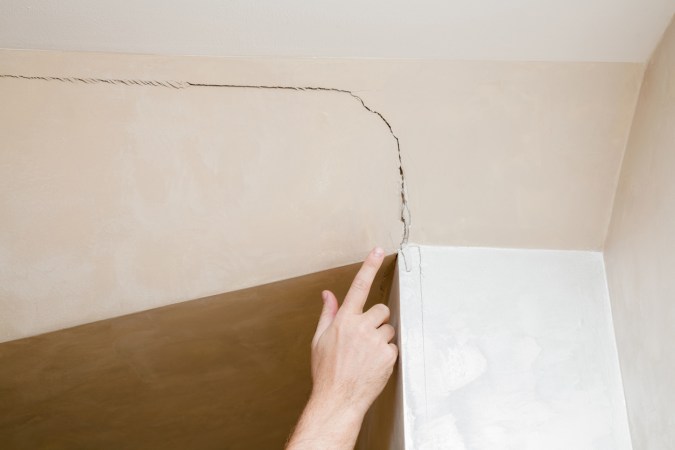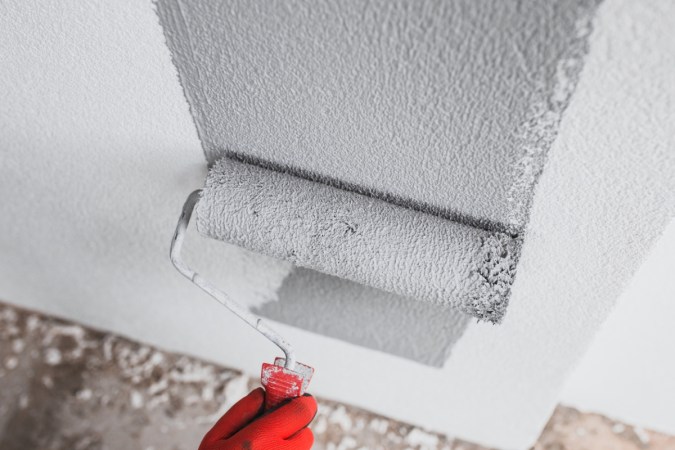We may earn revenue from the products available on this page and participate in affiliate programs. Learn More ›
Q. First-time deck painter here. I have prepared my deck as well as possible, scraping away old paint and sanding the wood. I am just wondering what is the best and most efficient way to tackle the job. Is it better to go with a brush, a roller, or another option that I haven’t considered? Is there anything else I should keep in mind?
A. It sounds as if you’ve given due attention to this important early yet critical phase; others would be wise to follow your example. Ahead, learn why prep is so important before painting a deck and find out how to select the right paint for the job.
Deck painting is a classic summertime project, but according to Jolene Jantz, Paint Advisor for Jantz Lumber and Do-It Center in McPherson Kansas, the key to a successful deck-painting project lies in the surface preparation. “All loose paint must be removed, and the surface must be clean and dry,” Jantz said. Once existing paint has been scraped away, and rough patches have been sanded smooth, the deck must be thoroughly cleaned. Only then is it ready to accept paint.
Painting a Deck: How to Prep for and Apply Paint
STEP 1: Wash Down the Deck
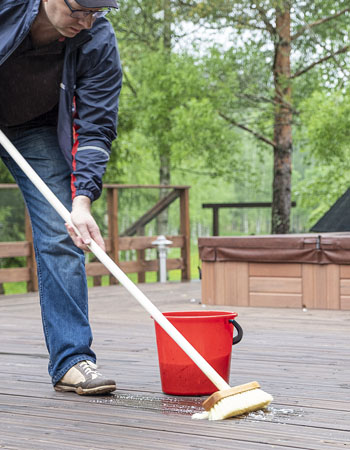
Even if it’s a new deck, it has to be clean before applying paint or stain. Deck-cleaning products are available that can be sprayed on using a garden hose dispenser and then brushed in with a utility broom or similar brush and then rinsed off. Consider the following when washing the deck.
- Deck cleaners: A general, all-purpose deck cleaning solution is suitable for washing the deck, and it will remove grime, dirt, and debris. For those who intend to apply a stain rather than a paint, Jantz recommends checking to see if the stain manufacturer recommends a specific deck cleaner.
- Brighteners: For non-painted wood decking that’s grayed unevenly over time, a cleaner that brightens the wood grain will help remove stains and discrepancies that might otherwise show through a new application of stain. These brighteners contain a wood-bleaching product to lighten stains and dark splotches.
- Mold and mildew: If any mold or mildew is present on the existing deck, use a cleaner with a mildewcide before painting or staining.
- Skip the power washer: Power washers are great for blasting away dirt and debris, but the powerful jet of water from a high-pressure washer can dig chunks of wood out of decking. After applying the deck-cleaning solution, scrubb with a stiff nylon-bristle brush (if needed). Use a garden hose with a jet nozzle to rinse away the cleaning solution, and then allow the deck to dry completely.
STEP 2: Scrape and Sand the Deck
All loose and peeling paint must be removed before repainting a deck. For the best results, rough surfaces should also be sanded smooth.
- Start with a wire brush: Use light sweeping strokes over the painted decking to dislodge loose paint. A wire brush makes quick work of getting rid of the loosest paint chips, although it likely won’t get all of them.
- Follow up with a scraper: Paint scrapers come in two common types, flat scrapers and curved scrapers. Flat scrapers resemble putty knives, and they work by positioning the blade at a low angle along the decking and giving it light pushes, so the blade slips beneath loose paint chips to remove them. This is a tried-and-true paint scraping method, but care must be taken not to gouge the wood with the blade. The blade on a curved scraper features a gentle arc at the end, and it works by pulling rather than pushing.
- Don’t skip the sanding: Scraping rarely removes all the paint from the existing deck, and it’s not meant to. After scraping away loose paint, it’s likely the wood will still have large areas of stuck-on paint, and that’s okay because if it’s not peeling, the new paint will still adhere. Sanding is still necessary to smooth out the edges between stuck-on paint and bare wood. A power sander hastens the sanding process, but try using a sanding sponge rather than regular sandpaper if one isn’t available. Before sanding, use a hammer and nailset to countersink any nails that might be sticking up.
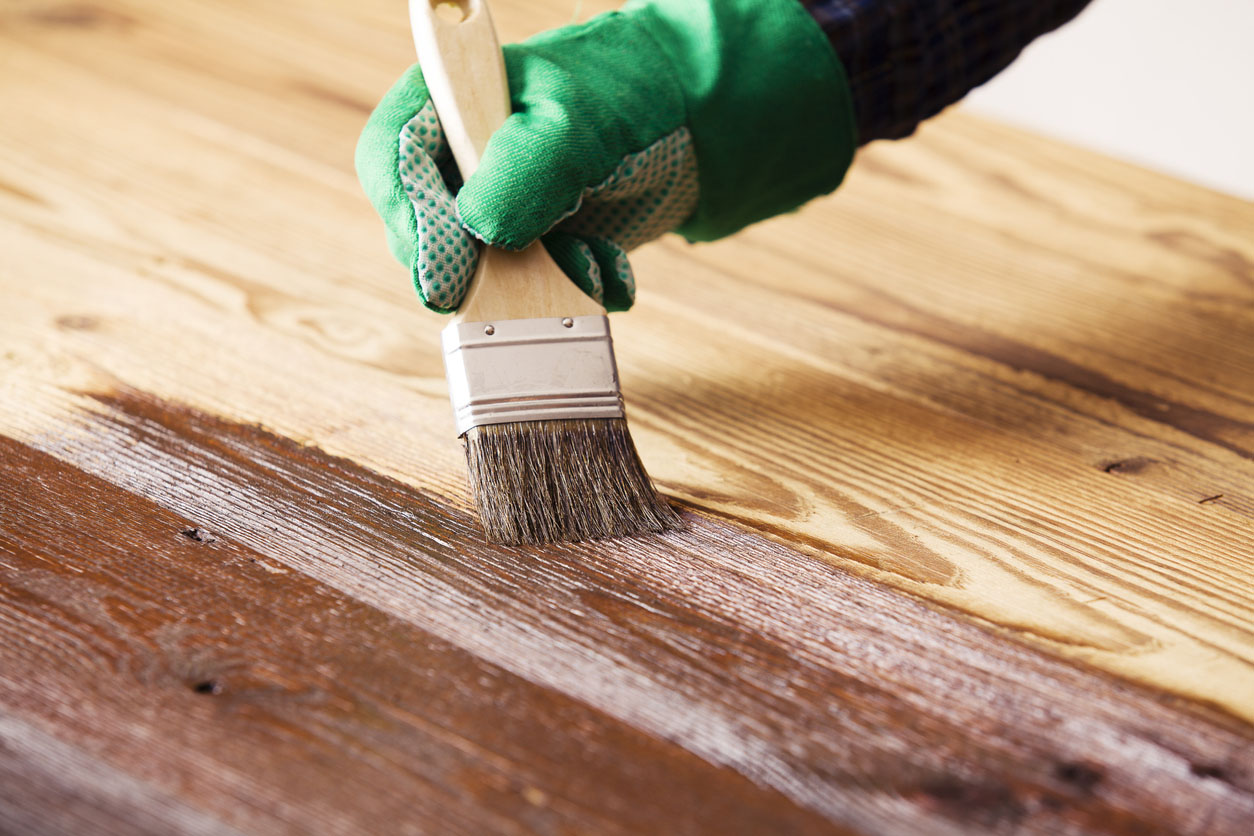
STEP 3: Apply Paint or Other Finish to the Deck
Before opening the can of paint or stain, apply painter’s tape to adjacent parts of a house or garage. After all the rest of the prep work, this is a minimal step. The tools chosen to apply the new finish deserve consideration as well.
- Roller: The best tool for applying new paint is a paint roller. A roller speeds the painting process, and it delivers a uniform coat of paint. The roller handle connects to an extension pole, making it easy to paint while standing up.
- Stain pads: Designed to make quick work of applying stain to non-painted wood decking, stain pads feature absorbent material, such as foam, and they also come with the ability to attach an extension pole.
- Brushes: Keep some brushes on hand for painting in restricted spots, such as when it’s time to paint deck railing or in other spots where a roller won’t fit.
- Don’t forget about the underside of the deck. If it’s reachable, paint or seal all deck boards’ sides to protect the decking from moisture. This is more critical in regions with heavy rains and high humidity than in arid regions. If all sides of the boards are not sealed, moisture may get into the wood and reduce the new paint’s longevity.
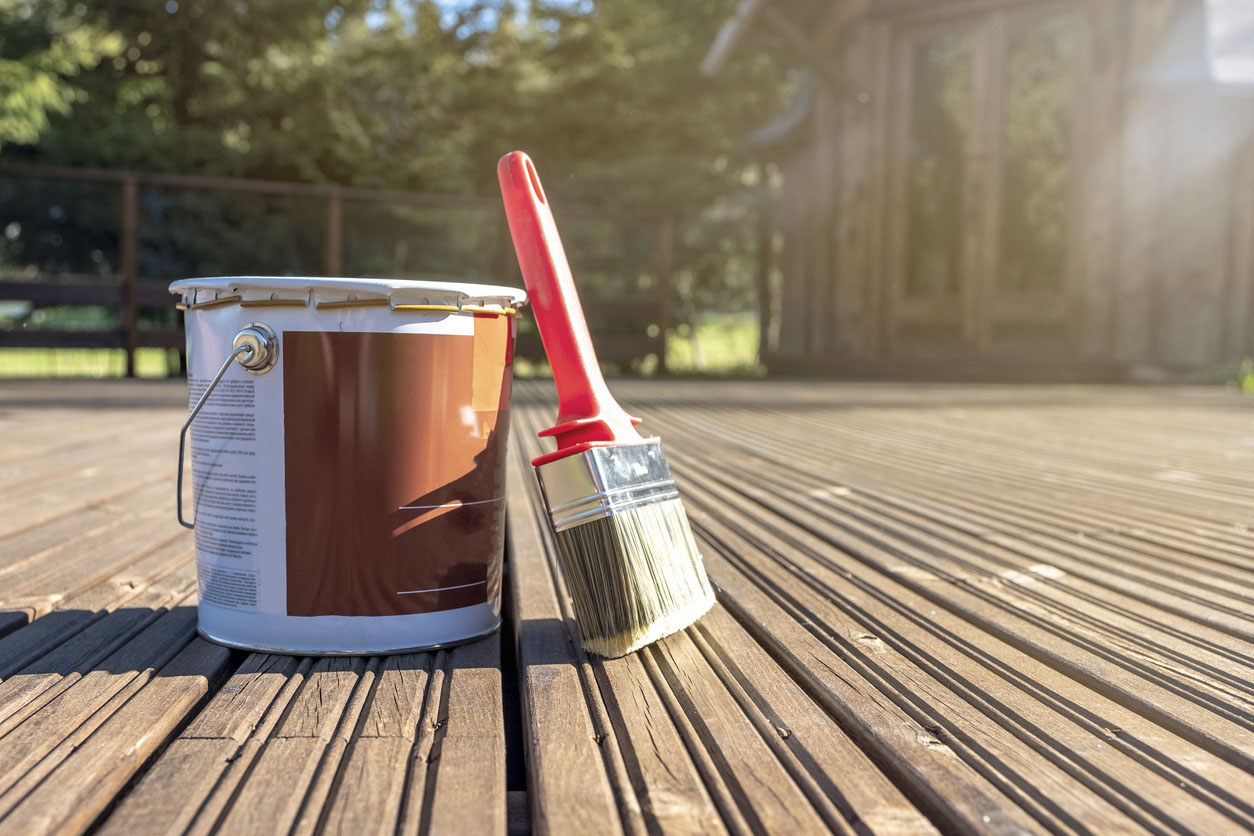
Picking a Deck Paint
A common mistake DIYers make when choosing deck paint is to buy exterior paint without first making sure it should be used on a deck floor. “The paint must be suitable for a horizontal surface,” Jantz said. Whereas all exterior paints will resist water damage to an extent, regular house paints are made to cover vertical surfaces, such as siding, where rain runs down and doesn’t sit on the painted surface. On the other hand, decking may retain small puddles of water after a rain. The paint for a deck or patio should be labeled as “floor paint” or “deck paint,” or the description should say that it can be used on horizontal surfaces.
Stain vs. Paint
To an extent, choosing between paint and stain is a matter of taste, but paint is thicker and more durable, while stain must be reapplied more frequently. As a general rule of thumb, deck stain is designed for use on bare or non-painted wood surfaces because although it imparts some color, it also allows the wood grain to show through. Deck stains come in various opacities; some offer just a hint of color, while others are semi-transparent or nearly opaque. The more pigments a stain contains, the more color it will impart. Most deck stains also include a sealer product that helps protect the wood from the elements. Choosing between paint or stain requires understanding the differences between the two products.
Paint does a better job of disguising imperfections, and it completely covers the wood grain. This makes paint well-suited for decks where a few boards have been replaced, and there’s an obvious difference between the new boards and the old boards. A coat of paint will hide the differences and give the deck a uniform, updated look.
That said, if the deck runs close to the ground or is located in a humid spot with poor air circulation, particularly if it’s had some problems with mold or mildew, then go for stain. While paint completely coats the wood, a stain penetrates the wood grain, but it does not form a solid coating on top as paint does. When moisture is a consistent factor, paint has a greater tendency to blister and peel. A penetrating stain and sealer combination will soak into the wood and protect from within.
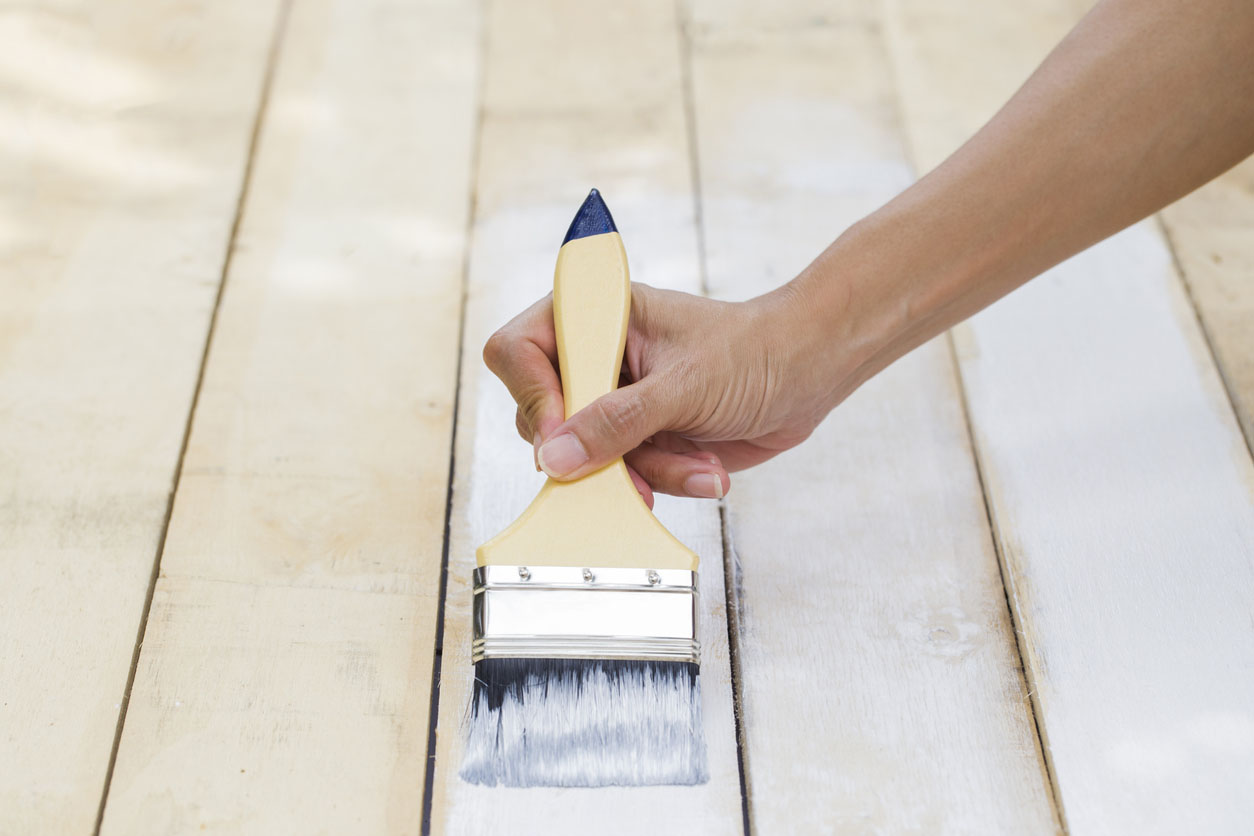
Primer Particulars for Deck Painting
Whether painting a new deck or updating an older painted deck, it’s usually—but not always—a good idea to apply primer to the wood before rolling on the paint. Jantz explains what to consider when choosing a primer.
- The existing type of deck paint: Before painting over a previously painted deck, find out whether the existing paint is oil-based or water-based. The general rule is to apply the same type of paint that’s already on the deck. For example, if the old paint is oil-based, use oil-based paint. If the old paint is water-based, use water-based paint. According to Jantz, it is possible to go over oil-based paint with water-based paint as long as a primer designed to convert from oil- to water-based paint is applied first.
- Paint/Primer combos: Some types of exterior floor and deck paints are designed to both prime the existing surface and add a new coat of color—all in one. When painting a deck with a combo product, there’s no need to apply a separate primer.
Correct and Cover
If the deck has splintered wood and gaps between the boards—if, in short, it’s seen better days—then you may want to consider a new crop of outdoor finishes that not only add color and protection but also correct minor flaws. Offered by a handful of manufacturers, these thick stains have a consistency reminiscent of cake frosting.
For instance, Behr makes a product called DeckOver, which the company claims can fill cracks up to 1/4-inch wide. This type of filler/paint product will smooth out the surface of decking that’s showing its age via gouges in the wood, nail holes, large pores, or obvious expansion cracks. If your deck is truly in rough shape and you have little time to put toward revitalizing it, DeckOver and similar products are probably worth the money. On the other hand, if your deck is in good condition, regular paint or stain would do just fine.
Find Out How Much Paint to Buy
When it comes to buying paint, it’s best to err on the side of caution and get more rather than not enough. Leftover paint can be used later for touchups if necessary. Still, you don’t want to end up with large cans that never get opened. Follow these steps to get an idea of how much you need.
- Measure the deck’s length and width and multiply the two numbers to determine the square foot of the surface. For example, a 10-foot by 20-foot deck has 200 square feet of surface. Most will also want to paint deck steps (if applicable), so measure those and add to the total.
- Double the total if you plan to apply two coats of paint. For the above example, that would be 400 square feet.
- Check the paint can to find estimated coverage and divide your number by this number. Many paints cover around 350 square feet. Still using the above example, divide 400 by 350 to determine it would take approximately 1.14 gallons to coat the surface of the deck twice. A lot of exterior paint sells by the gallon, so the user would want to pick up 2 gallons of paint to be on the safe side.
- Don’t forget the primer. If the paint isn’t a paint/primer combo product, use the same method to figure a single coat of a separate primer.
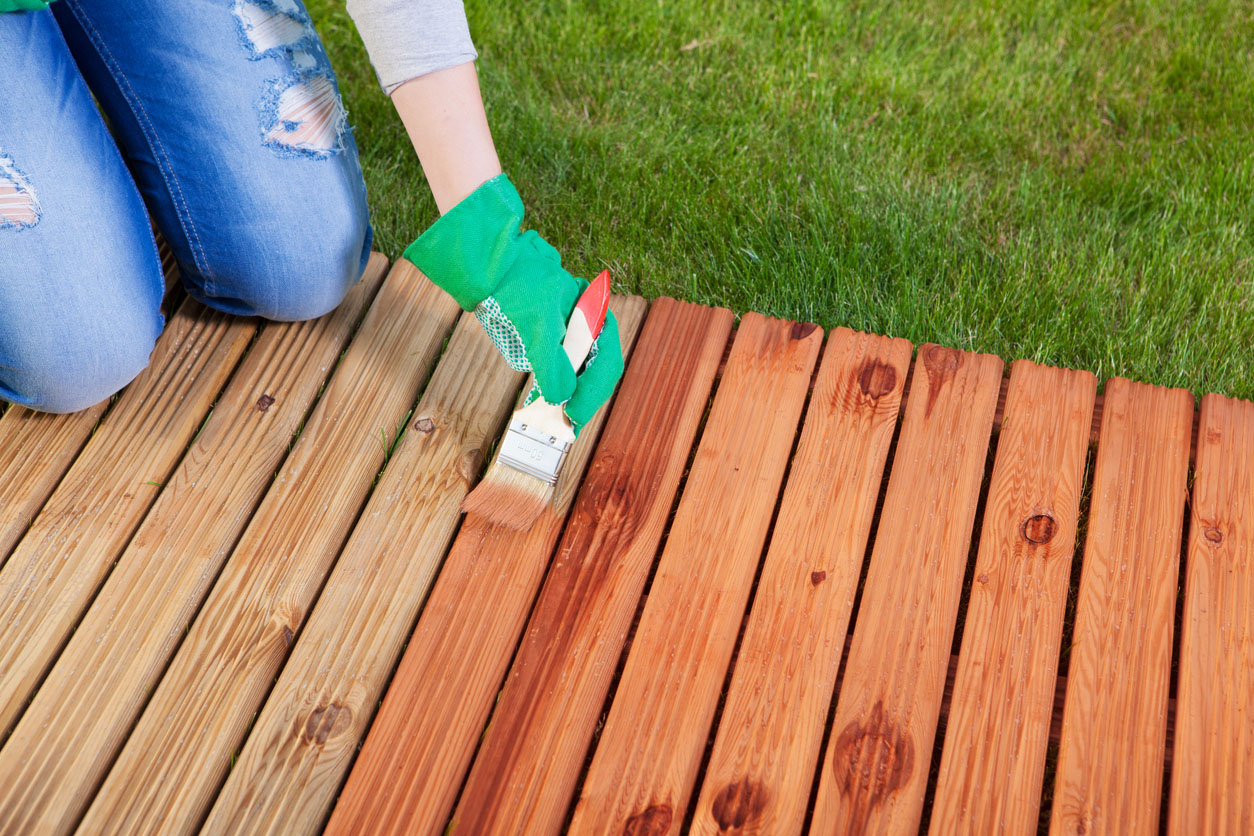
Painting a Treated Deck
High-end decks made from redwood, teak, or cedar naturally resist water damage, but they too can benefit from the application of a clear sealer that penetrates the wood grain and slows down the weathering process.
Most decks, however, are built from treated—yellow pine that’s been soaked in chemicals to keep it from rotting. Jantz explains that treated decks need adequate time for the chemicals to evaporate from the wood before adding paint or sealant. If a deck is painted before the chemicals have completely evaporated, the paint is more likely to peel off. Jantz recommends waiting six months after the deck is constructed to give it ample time for the chemicals to evaporate before painting or sealing.
FAQ About How to Paint a Deck
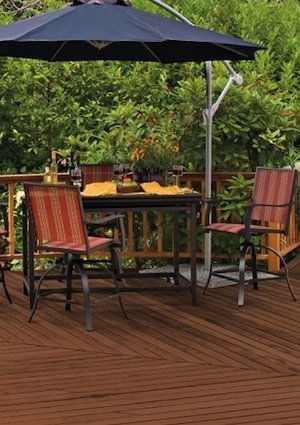
Spending time on a deck is a favorite warm-weather activity for many, so it makes sense to protect the deck to maintain its beauty and extend its useful life. For those thinking about painting or sealing the backyard deck, a few questions are to be expected.
How do you prepare a deck for painting?
Clean the deck thoroughly, remove all loose paint, and then sand the deck and let it dry completely.
Can you paint over old deck paint?
Absolutely! Just make sure to prep the deck as detailed above and choose a deck paint that is compatible with the current paint.
What kind of paint do you use on a wood deck?
Either oil-based or water-based exterior deck paints are suitable, but they should be designed for use on horizontal surfaces—not just exterior paint designed for use on a house or a fence.
Is it better to paint or stain a deck?
If the deck was previously painted, it’s best to paint it again. If the wood is bare, either paint or stain is acceptable—it’s mostly a matter of personal preference.
Final Thoughts
A new coat of paint or stain will update a deck and give it new life and appeal, but before grabbing a roller, it’s crucial to correctly prep the deck. The actual process of rolling or brushing on paint or stain is relatively quick and straightforward compared to the time it takes to prep a deck—especially if it’s an older deck with loose paint or mold problems.

